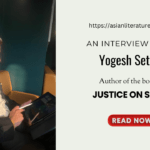
Title: A Text Book of British Literature: 18th Century and British Romantic Literature
Author: Umar Farooque
ISBN: 978-93-7335-227-5
Publisher: Evincepub Publishing
About the author: Umar Farooque is a dedicated scholar of English literature with a deep interest in the evolution of British literary thought and aesthetics. His academic pursuits focus on tracing the transition from the rationalism of the Enlightenment to the emotional depth and creative imagination of the Romantic era. With a strong background in literary criticism and pedagogy, he brings clarity and insight to complex literary movements and their historical contexts.
Through his work for MJC English Semester-5th Paper-8th & 9th, Farooque aims to make classic English literature accessible to students, teachers, and general readers, emphasizing both textual analysis and cultural understanding. British Literature: 18th Century and British Romantic Literature reflects his commitment to fostering literary appreciation and critical inquiry among learners and researchers alike.
Q1: What inspired you to write A Text Book of British Literature: 18th Century & British Romantic Literature?
Answer: I was inspired to write A Text Book of British Literature: 18th Century & British Romantic Literature to provide students with a clear and comprehensive understanding of two pivotal literary periods.
My goal was to bridge classical insights with modern interpretations for better academic engagement.
I aimed to make complex literary themes accessible while highlighting the evolution of thought, style, and emotion in British writing.
Q2: How did your background as a scholar and teacher of English literature influence this book?
Answer: My background as a scholar and teacher of English literature deeply shaped the book’s structure and approach. Years of classroom experience helped me understand students’ difficulties with literary analysis and historical context. This insight guided me to present the material in a clear, engaging, and academically balanced manner, blending scholarship with pedagogy.
Q3: What was your main goal in compiling this volume for students and literary enthusiasts?
Answer: My main goal in compiling this volume was to provide students and literary enthusiasts with a comprehensive yet approachable guide to British literature’s 18th-century and Romantic phases.
I aimed to simplify complex literary ideas without losing their academic depth.
Ultimately, I wanted readers to appreciate the intellectual vigor and emotional richness that define these transformative periods.
Q4: Why did you choose to focus specifically on the 18th Century and Romantic periods of British literature?
Answer: I chose to focus on the 18th Century and Romantic periods because they represent two defining and contrasting phases in English literary evolution. The 18th century emphasized reason, order, and satire, while the Romantic era celebrated emotion, imagination, and individuality. Together, they trace the shift from classical rationalism to the awakening of human spirit and creativity in literature.
Q5: How do you personally interpret the transition from the Age of Reason to the Age of Emotion in British writing?
Answer: I interpret the transition from the Age of Reason to the Age of Emotion as a profound shift in the human outlook expressed through literature.
Writers moved from valuing logic, order, and social conformity to celebrating imagination, individuality, and emotional depth.
This change reflects humanity’s growing desire to understand not just the external world but the inner landscape of the soul.
Q6: The book covers two dynamic periods — Enlightenment and Romanticism. How do you see them as connected or contrasting?
Answer: I see the Enlightenment and Romanticism as both connected and contrasting phases of literary and intellectual growth.
The Enlightenment laid the groundwork with its emphasis on reason, inquiry, and moral order, while Romanticism reacted by reclaiming emotion, nature, and spiritual freedom.
Together, they form a dialogue between intellect and imagination—two forces that continually shape human expression.
Q7: How did you approach balancing historical background with literary analysis in your writing?
Answer: I approached the balance by intertwining historical context with close literary analysis throughout the book.
Understanding the social and intellectual background helps readers grasp why writers expressed certain themes or styles.
Thus, each chapter situates the literature within its historical moment while engaging critically with its artistic and philosophical dimensions.
Q8: Which author or text from these periods do you find most fascinating, and why?
Answer: Among these periods, I find William Wordsworth particularly fascinating.
His poetry embodies the Romantic spirit—uniting nature, emotion, and philosophical reflection in a profoundly human way.
Through works like Lyrical Ballads, he transformed poetry from an elite art into a universal voice of feeling and experience.
Q9: What do you hope readers—especially students—take away from this book?
Answer: I hope readers, especially students, gain a deep appreciation of how literature mirrors human thought, emotion, and social change.
I want them to see the 18th and Romantic centuries not as distant eras, but as living dialogues about reason, imagination, and the human condition.
Ultimately, I hope the book inspires critical thinking, aesthetic sensitivity, and a lifelong love for English literature.
Q10: How does your book align with the National Education Policy (NEP) 2020 and the new FYUGP curriculum?
Answer: My book aligns closely with the National Education Policy (NEP) 2020 and the new FYUGP curriculum by promoting holistic, multidisciplinary, and learner-centred education.
It encourages critical thinking, contextual understanding, and appreciation of cultural diversity—core objectives of NEP 2020.
The text is designed to support outcome-based learning, integrating literary knowledge with analytical and ethical perspectives suited to the new academic framework.

